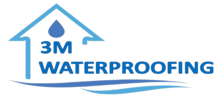Waterproofing is a fascinating process that combines science and technology to safeguard buildings from water damage. It may seem simple on the surface, but the principles behind waterproofing involve physics, chemistry, and engineering. Understanding how waterproofing works can help you appreciate its importance and the role it plays in protecting your home. This article delves into the science behind waterproofing and explains how it keeps your home safe and secure.
What Is Waterproofing?
Waterproofing is the process of making a structure resistant to water infiltration. It involves using materials and techniques that block water from entering or passing through surfaces like walls, roofs, and floors. The goal is to prevent moisture from causing damage to the building and its contents.
Why Water Is a Problem for Homes
Water can cause serious issues when it enters a home. Here are the main problems water can create:
- Structural Damage: Water weakens the foundation of your home by eroding concrete and soil. This can lead to cracks and instability.
- Mold Growth: Moisture creates an ideal environment for mold and mildew, which are harmful to health.
- Damage to Belongings: Water can ruin furniture, electronics, carpets, and other items in your home.
- Energy Loss: Damp insulation becomes less effective, increasing energy bills. These issues highlight why waterproofing is essential for any home.
The Science Behind Waterproofing
Waterproofing relies on scientific principles to block or redirect water. Below are key scientific concepts that make waterproofing effective:
Hydrophobic Materials
Many waterproofing products use hydrophobic materials. These substances repel water molecules and prevent them from adhering to surfaces. Examples of hydrophobic materials include silicone and certain polymers. They create a barrier that water cannot penetrate.
Capillary Action Prevention
Capillary action occurs when water rises through small pores or cracks in materials like concrete. Waterproofing stops this by sealing the pores and cracks, preventing water from moving upward.
Vapor Barriers
Some waterproofing methods use vapor barriers to stop water in its gaseous form (humidity) from entering a home. These barriers are made of materials like plastic or foil that block moisture from passing through.
Drainage Systems
Waterproofing often involves installing drainage systems to redirect water away from the home. This uses gravity to move water to a safe location, preventing it from pooling near the foundation.
Types of Waterproofing
There are various methods of waterproofing, each based on scientific principles. Here are the most common types:
Liquid Membranes
Liquid membranes are made of hydrophobic materials like polymers. They are applied as a coating on surfaces and form a waterproof layer once they dry.
Sheet Membranes
These are thin layers of waterproof materials, like rubber or plastic, that are placed on surfaces. They create a physical barrier against water.
Cementitious Waterproofing
This method uses cement-based products that fill cracks and pores in concrete. The cement hardens and blocks water from passing through.
Bituminous Coating
Bituminous coatings are made from asphalt or tar. They are highly waterproof and commonly used for roofs and foundations.
Drainage Systems
Drainage systems use pipes and channels to guide water away from the home. They prevent water from accumulating near the foundation.
How Waterproofing Protects Your Home
Waterproofing provides several layers of protection for your home, ensuring its safety and longevity. Here’s how it helps:
Prevents Structural Damage
Waterproofing keeps water away from the foundation of your home. This prevents soil erosion and concrete deterioration, ensuring the structure remains stable.
Stops Mold Growth
By reducing moisture, waterproofing eliminates the conditions needed for mold and mildew to grow. This keeps your home healthy and safe.
Protects Insulation
Waterproofing ensures that insulation stays dry and effective. This helps maintain indoor temperatures and reduces energy bills.
Keeps Belongings Safe
Furniture, electronics, and other items are protected from water damage when your home is waterproofed.
Reduces Maintenance Costs
Homes without waterproofing often require frequent repairs to address water-related issues. Waterproofing minimizes these problems, saving you time and money.
The Role of Professionals in Waterproofing
Waterproofing is a complex process that requires expertise. Professionals use advanced materials and techniques to ensure your home is properly protected. They assess the specific needs of your home and recommend the best waterproofing solutions.
Scientific Testing
Experts conduct tests to identify weak spots in your home where water may enter. These tests use scientific methods, such as moisture meters and infrared cameras, to detect problem areas.
Customized Solutions
Every home is different. Professionals design customized waterproofing systems that suit the specific conditions of your property, ensuring maximum protection.
How to Maintain Waterproofing
Waterproofing is not a one-time solution—it requires regular maintenance to stay effective. Here are some tips for maintaining waterproofing:
- Inspect for Damage: Check walls, roofs, and basements for cracks or leaks.
- Clean Drainage Systems: Keep pipes and channels clear of debris to ensure water flows away from your home.
- Reapply Coatings: Over time, coatings may wear off. Reapply them as needed to maintain protection.
The Cost vs. Benefits of Waterproofing
While waterproofing can be expensive, it is an investment that pays off over time. The cost of repairing water damage or health issues caused by mold is much higher than the cost of waterproofing. It provides peace of mind, knowing your home is safe from water-related problems.
Conclusion
Waterproofing is a combination of science, technology, and engineering that protects your home from water damage. By using hydrophobic materials, preventing capillary action, and installing drainage systems, it creates a strong defense against moisture. Waterproofing ensures the safety, value, and comfort of your home. It is truly worth every penny to invest in this essential process.
The science behind waterproofing may be complex, but its benefits are clear. It keeps your home dry, sturdy, and healthy, saving you money and stress in the long run. Protecting your home with waterproofing is not just an option—it is a necessity for every homeowner.

